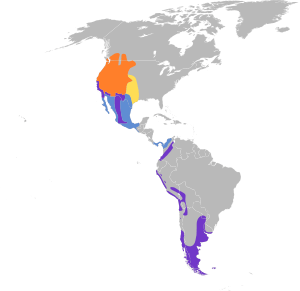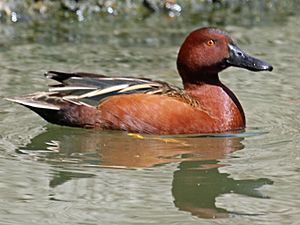Cinnamon teal facts for kids
Quick facts for kids Cinnamon teal |
|
|---|---|
 |
|
| Spatula cyanoptera septentrionalium drake (male) | |
| Conservation status | |
| Scientific classification | |
| Genus: |
Spatula
|
| Species: |
cyanoptera
|
| Subspecies | |
|
4 living, 1 possibly extinct; see text |
|
 |
|
| Synonyms | |
|
Anas cyanoptera Vieillot, 1816 |
|
The cinnamon teal (Spatula cyanoptera) is a colorful type of duck. You can find these ducks in western North America and South America. It's a small dabbling duck, which means it feeds by tipping its head into the water.
Male cinnamon teals have bright reddish feathers. Females are a duller brown color. These ducks like to live in marshes and ponds. They mostly eat plants.
Contents
What Does a Cinnamon Teal Look Like?
Adult male cinnamon teals have a reddish-cinnamon head and body. Their back is brown, and they have a red eye. Their bill, or beak, is dark.
Adult female cinnamon teals look different. They have a spotted brown body and a light brown head. Their eyes are brown, and their bill is gray. Females look a lot like female blue-winged teals. However, female cinnamon teals are usually a richer brown color. Their eye markings are also less clear. Their bill is longer and shaped more like a spoon.
Young male cinnamon teals look like female cinnamon or blue-winged teals. But you can tell them apart because their eyes are red.
These ducks are about 16 inches (41 cm) long. Their wings can spread about 22 inches (56 cm) wide. They weigh around 14 ounces (400 grams). Cinnamon teals change their feathers twice a year when they are adults. They have an extra molt in their first year.
Where Do Cinnamon Teals Live?
Cinnamon teals build their nests in marshes and ponds. They breed in the western United States and the very southwestern part of Canada. Sometimes, they visit the east coast of the United States, but this is rare.
Cinnamon teals usually find a new mate each year. These ducks are migratory, meaning they fly to warmer places for winter. Most of them spend winter in northern South America and the Caribbean. They usually don't fly as far south as blue-winged teals. Some cinnamon teals stay for winter in California and southwestern Arizona.
There are two types of cinnamon teals that live in the Andes mountains of South America. One type, called S. c. cyanoptera, is smaller. It lives in lower areas, below 1,000 meters (3,280 feet). You can find it along the coast of Peru and in southern Argentina. The other type, S. c. orinomus, is larger. It lives in very high places, from 3,500 to 4,600 meters (11,500 to 15,090 feet) high in the central Andes.
How Do Cinnamon Teals Behave?
These ducks find their food by "dabbling." This means they tip their bodies forward in the water. They keep their tail up and their head down to reach food underwater. They mostly eat plants. Sometimes, they also eat small water creatures like molluscs (like snails) and aquatic insects.
Types of Cinnamon Teals
Cinnamon teals are very closely related to blue-winged teals. They are even known to breed with blue-winged teals sometimes.
Scientists have identified different types, or subspecies, of cinnamon teals:
- Spatula cyanoptera septentrionalium: This is the northern cinnamon teal. It breeds from British Columbia down to northwestern New Mexico. These ducks spend their winters in northwestern South America.
- Spatula cyanoptera tropica: This is the tropical cinnamon teal. It lives in the Cauca Valley and Magdalena Valley in Colombia.
- Spatula cyanoptera borreroi: This is Borrero's cinnamon teal. It might be extinct. It used to live in the eastern Andes of Colombia. There are also records of these birds living in northern Ecuador. This subspecies is named after a Colombian bird expert, José Ignacio Borrero.
- Spatula cyanoptera orinoma: This is the Andean cinnamon teal. You can find it in the Altiplano region of Peru, northern Chile, and Bolivia.
- Spatula cyanoptera cyanoptera: This is the Argentine cinnamon teal. It lives in southern Peru, southern Brazil, Argentina, Chile, and the Falkland Islands.
See also
 In Spanish: Cerceta colorada para niños
In Spanish: Cerceta colorada para niños





